by Ross Nickerson
Playing the melody on the banjo is tricky and takes focused technique practice. Naturally it is the first thing students want to do on a banjo, but because of its difficulty it most often comes later.
Your most important function as a banjo player is to provide a steady rhythm of 1/4 and 1/8th notes. This a steady stream of notes played in time that lay down a rhythm. Within that steady rhythmic drive we then learn to accent and bring out the melody notes. That is the tricky part. If you try to play the melody notes first and then somehow drop in the rhythmic fills necessary to sustain the melody notes, that approach in my experience is putting the cart before the horse. You must first teach the horse to gallop in a straight line and then we can worry about turns, jumps and other moves which could be compared to then adding in the melody.
One thing I should clarify is that I am speaking of songs that are normally sung, not fiddle tunes that often have a melody note for each 1/8 note. Turkey in the Straw would be an example of a fiddle tune with melody notes primarily 1/8 notes with a few 1/4 notes. Playing the song Country Roads on the Banjo would be an example of playing a melody on the banjo that is normally sung.
You’ve likely learned rolls first and then some chords. That is a great way to start, to be able to pick one measure rolls and change chords through the full progression of the song. In this lesson I am going to teach you some exercises using rolls with different accented notes indicated so you can develop the skills needed to accent and bring out the melody note. Once you have exercised and challenged yourself with many different combinations of fingers accented in the roll, you will be much more ready to react to what you hear, and bring out the melody.
First let me state that a measure in the examples used is four 1/4 beats which is called 4/4 time. Remember, two 1/8th notes counts as one 1/4 beat. So any combination of 1/4 notes and 1/8 notes that equals 4 beats is a measure.
I’ve added accent marks above the notes to be accented. > An accented note should be hit about 30% harder especially at first, not a slight nudge, but hit it hard, Later when you develop finesse, you learn to back off the fill notes around the melody note too. but if you are just starting this technique, give the accents a good whack. You can smooth it later when you get the hang of it.
The first roll is a forward roll. A forward roll is most often used to sustain a whole note which is a melody note that holds four beats. Sustaining a note for four beats is a challenge because on a banjo if we hit the note once, the maximum we can sustain that note is 1/4 beat, unlike a horn, fiddle or voice for instance. The forward roll is used to sustain the melody note each time you come around the roll and accent it. This could further be described as the way a 5 string banjo player plays a whole note, a note that is normally sung and held for four 1/4 beats.
In the Scruggs style the thumb is used most to play the melody. I would call the thumb the preferred finger to play the melody with, except when the melody note is on the first string. In this example, start the roll on the thumb. Even though we want to use the thumb to play the melody, sometimes the thumb is not available and this roll would be need to be started on the index finger. Remember, one of the tricks to playing the banjo fast is we do not use the same finger twice on consecutive 1/8 notes. So, if the thumb was used previously on an 1/8 note we must sometimes start this roll with the index. Note: Consecutive 1/4 notes can be played with the same finger and often are, especially with the thumb. It’s coming from an 1/8 note that you alternate the finger, try not to confuse that.

*Now practice starting the roll on the 2nd string, next the 4th string.
*Then mix up the strings the index finger plays. Continue to put the melody accents in the same place
*Next you could practice playing the two 5th strings in the roll on the 4th or 3rd string.
*Also practice the roll starting with the index finger.
One of the best ways to emphasize the melody is simply play the melody note as a quarter note and not attach an 1/8th note to it. In this example below, hit the 1/4 note hard and then sustain it with the forward roll. Important, this is counted, 1 2 + 3+ 4+
Notice how the thumb is used again after the 1/4 note, that’s ok, and proper technique. You have plenty of time after a 1/4 note to use the same finger twice.
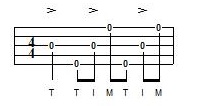
With this alternating Roll, accent the first and third beats of the measure which gives you practice accenting half notes in a melody (1/2 notes are two beats).
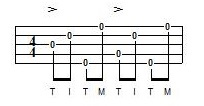
*Next, mix up the strings the thumb plays. Continue to put the melody accents in the same place
In these two rolls practice accenting the 1st and 4th beats of the measure. These forward reverse and forward backward rolls are used often in measures of a song where the melody is on the 1st and 4th beat of the measure, which is pretty common.

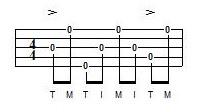
*Next, substitute hitting the 4th string on the first beat of the measure and the 3rd string on the 4th beat of the measure, the 1st and 4th beats are where the accent marks are.
In the last example the melody note is a quarter note. We can either play it as a quarter note or stick a 1/8 note between each 1/ 4 note.
If the actually melody note is a 1/4 note we can also choose to play it as a quarter note which brings out the melody the best in many cases. or a combination of 1/4 and 1/8 notes. the third example is counted. 1 + 2+ 3 4
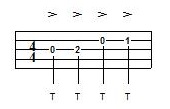
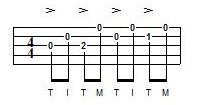

Keep in mind that now that you have been taught which notes to accent in these roll examples, when you see the same roll in a song you are learning, the melody notes will likely be in the same place in the roll where I taught you to accent. That is why the roll was used, because it was the best roll to get the melody note where you wanted it or where it would stand out most.
Here is a link to the song I’ll Fly Away so you can see how the rolls you learned and where the accents were in the roll is used works in a song.
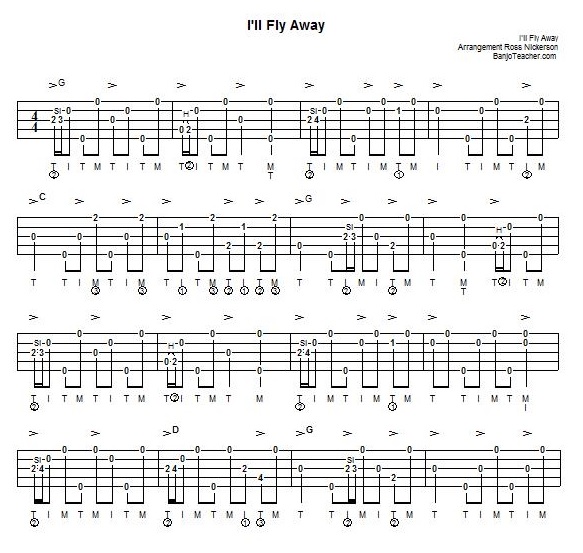
Free Video of more advanced version of I’ll Fly Away
For more information on how to play the melody better on 5 string banjo.
The Banjo Encyclopedia “Bluegrass Banjo From A to Z”
More Ross Nickerson Resources
Playing By Ear and Learning the Chords
How to Practice Banjo DVD
Banjo Play Along and Practice DVD”
Essential Banjo Licks DVD
Other Ross Nickerson Books and DVDs

